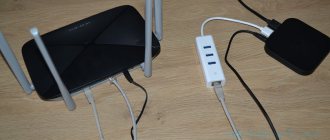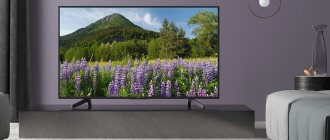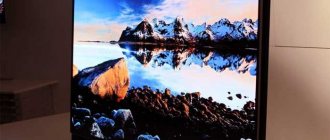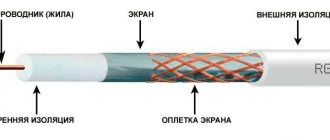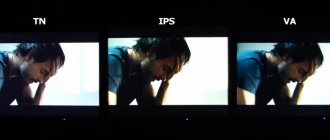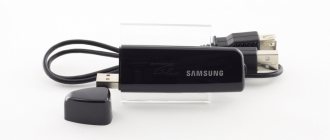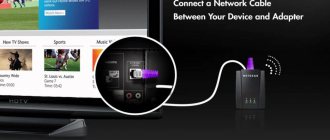What is a Wi-Fi adapter for a digital TV set-top box?
The DVB T2 receiver with wireless network works using a router. This device is bought for a PC. The adapter has the following characteristics:
- receiving a signal over a long distance;
- powerful transmitter model;
- reliable protection against illegal actions of burglars.
The Wi-Fi adapter looks like a flash drive, which is inserted into a special connector. All color TVs have a USB port.
Principle of operation
In order not to go into technical details that will be of interest to few people, you need to consider the general principles of the device’s operation. The adapter works using two technologies:
- Digital Living Network Alliance (DLNA) technologies are a set of standards and protocols that allow configured and compatible devices to wirelessly transmit and receive various media information on a home local network. Moreover, the standard supports the transmission of streaming, that is, a stream of media data in real time;
- AirPlay technology is the same wireless data transfer technology from Apple, which includes the same protocols and standards and allows for streaming audio and video content between compatible devices. Designed to work with Apple products – iPhones and iPads.
Review and configuration of the D-Link Dir-320 modem
Wi fi adapter for dvb t2 set-top boxes is equipped with the simplest Wi-Fi adapter and signal decoder. The device receives wireless signals and transmits them as content via an HDMI connection to the TV.
Important! With the growth of technology capabilities, the capacity of such channels and the speed of data transfer are increasing. Even movies in FullHD quality can be played back without lags or stutters.
Why do you need a USB Wi-Fi adapter for a digital set-top box?
For correct operation of digital TV you need:
- a device that acts as a network access point (for example, a router or smartphone);
- client device receiving the signal.
Wi-Fi works on the same principle as a smartphone - it transmits data via radio waves. The adapter is necessary so that the data is converted into signals, which will subsequently enter the antenna through the decoder.
Which TVs show digital channels without a set-top box: 2021 list
If you have any questions or complaints, please let us know
Ask a Question
If the TV supports Smart, then you can watch IPTV and use the Internet. In the interior I want to reduce the number of wires from devices. The adapter will help you realize this desire.
Method No. 2
Let's look at how to connect a Rostelecom TV set-top box via WIFI using a WiFi AP access point. This connection to IPTV wirelessly is more universal: there is no binding factor to the compatibility of equipment of various types.
The WiFi access point connects the STB to the provider’s existing network via WiFi, operates in client mode and redirects the video stream to the TV set-top box. In this case, you can connect a set-top box (STB) to the router using a regular network cable (patch-cord).
How to choose the right Wi-Fi adapter for a TV set-top box
Before purchasing a Wi-Fi antenna for a digital set-top box, read the technical specifications. Install drivers on the TV that will help its continuous operation. Developers create wireless adapters that differ in capabilities and price. But they are used for one purpose and have a general operating principle. But not all models are suitable for a specific TV. It is better to buy a router from the same manufacturer as the TV. Developers specifically design additional devices that work with each other. The likelihood that they will not fit the TV is minimal. Correct operation is expected if:
- drivers are compatible;
- the same type of frequencies and maximum radio signal power are used;
- the optimal working radius is applied.
By analyzing such indicators, adapters are selected. As a result, there will be no need to study in detail the technical features of the proposed devices. The developers foresaw this in advance.
Basic Specifications
The model has sufficient power for convenient viewing of TV channels. The detailed specifications are as follows:
- Works in IEEE 802.11b/g and 802.11n data transfer protocols.
- Supports USB 1.1 and 2.0 interfaces.
- Receives signals in the ranges from 2.412 to 2.4835 (in accordance with country regulations).
- The data transfer rate in the 802.11b/g standard is 54 Mbit/s, throughput is 27 Mbit/s.
- In the 802.11n standard, the speed is 150 at 90 Mbit/s, 300 at 160 Mbit/s, 300 Mbit at 260 Mbit/s for 1T1R, 1T2R and 2T2R, respectively.
- Data protection is carried out using WPA, WPA2 and WEP 64/128 technologies.
- The data transmission radius indoors is 100 meters, outdoors – 300 meters.
Supported operating systems: Linux, Windows 98/Xp/7/8 and Mac OS X.
Main characteristics
To spend your money wisely, focus on the main characteristics. We talk about them in detail below.
TV Compatibility
The purchased device is provided with instructions that describe in detail how to use it. It also indicates which TV models it is compatible with. The brands of devices with which the correct connection occurs are often written on the packaging. This data can also be checked on the manufacturer’s official website. You can also check the information in the store with a consultant.
Transmitter power
This parameter is not easy to determine. It becomes difficult to determine the distance at which the work is correct. These indicators are configured after opening the main menu of the router.
For an uninterrupted signal, a power of 17 dBm is sufficient. Low indicators form lags. If the router is located in a small building, then there is no need for higher performance. This may become a waste of money.
How to install Okko on Smart TV and watch for free: instructions
Operating frequency
This indicator is considered one of the most important when choosing a device. Because compatibility settings depend on it. The adapter must have the same operating frequency as the router.
Signal standard
This indicator is not as significant as the previous one, but also affects the quality of the connection. The speed can be real and maximum. This data is indicated in the device parameters, Mbit/s is noted. The required standards are listed below.
Keep in mind that maximum parameters can rarely be obtained in real conditions. The main reason is interference generated from the wall due to bad weather conditions and other things. This also happens due to household appliances. Even water can absorb radio waves.
Radius of action
This parameter conditionally divides models into two types: for indoors and open space. The indicator is measured in meters. Each device has a specific digital value. The higher it is, the farther the device is installed from the signal point. But only if there are a minimum number of obstacles in his way.
Protection and encryption methods
Developers always try to create conditions to provide for unauthorized transfer of data. As a result, you cannot use the router without knowing the password. It is recommended to come up with complex combinations to provide for hacking.
The user creates a complex name for the router and a password with a high level of protection. For maximum protection, you can make the network invisible through the settings.
WiFi USB adapter for T2 tuner and its minor modification
Some time ago I had a review of the T2 tuner, and then we started talking about the fact that the functionality of such tuners can be expanded a little, adding WiFi to the usual functions. But the difficulty was that tuners cannot work with all adapters, and my experiment with two “test subjects” only confirmed this. During the discussion, they suggested to me which chip the adapter should be on for the T2 tuner to “see” it, so I accordingly bought such an adapter and decided to write a short review report. All these “dancing with a tambourine” stem from the fact that the driver base for T2 tuners is very limited and, unlike computers where drivers can be additionally installed, here you have to either limit yourself to the meager selection of adapters, or somehow modify the tuner software, and in reality the latter I highly doubt it.
The choice fell on a model for which it was stated on the product page that it was compatible with T2 tuners, reviews from happy customers only confirmed this. The adapter costs $2.98, although taking into account paid delivery it came out to as much as $4.17, but in my opinion it’s not that expensive for the opportunity to watch not only broadcast channels, but also online videos.
After some time, I picked up an envelope with an adapter packed in a blister at the post office.
The kit is simple, an adapter and a disk with drivers, and instructions on the package.
Externally, it is the most ordinary adapter, near the USB connector the activity indicator blinks blue when transferring data, and shines continuously when idle.
The antenna is long, about 15-17cm, if you add the length of the adapter itself with the connector, you get the stated 20-21cm.
I was interested in whether there was actually a full-size antenna inside, but the reality turned out to be much more cruel, most of it is just plastic 
And the antenna itself is a short, thin wire.
For those who don’t know what a proper antenna looks like inside, I’ll show you a complete one from another device, a review of which is also planned in the near future.
This situation did not suit me, but not because the sensitivity of the antenna will not be very high, but because I don’t need a long pin here and will only get in the way. Accordingly, it was decided to shorten the body a little. According to my estimates, it turns out that 70mm of plastic is superfluous.
Then everything is simple, I cut off the excess with a knife, and then use a drill to slightly drill out the first 15mm of the inner part, otherwise it simply won’t fit on the adapter.
As a result, I get a pretty decent and not very long antenna, personally, in my opinion, this is even better and neater.
In the process I forgot to write, the angle of rotation of the antenna relative to the body is only 90 degrees, very little, in some situations a long antenna could greatly interfere.
On a TV tuner it turns out to be turned away from the antenna connector.
Before moving on to tests with the tuner, I’ll check the work with the computer. When connecting, I received a message that the device was not recognized, drivers are required.
Okay, let's go online and download the drivers for the Ralink adapter, which is detected by vid&pid. The first drivers did not help in any way, and the crooked translation familiar to many users of these adapters is immediately visible. We remove the driver, try to install a newer version, by the way, with the already normal Russian language.
Alas, it's a bummer. No, of course you could get a DVD drive out of the cabinet, a SATA-USB adapter for it and install everything from the original drive, but somehow this is... not sporty.
So I go online again and download Ralink RT5370 drivers for adapters... TPlink, installed absolutely without problems 
There are somehow very few adapter settings, or I’m just spoiled by more “advanced” devices. By the way, branded Ralink drivers are very convenient; if I wanted to use this adapter with a computer, I would only install them.
Sensitivity in general is slightly above average; in search mode, 42 access points were found, two of which are mine, this is the main router and an additional one operating in repeater mode. Yes, this adapter only works in the 2.4 GHz band.
The speed within a large room almost does not change depending on the distance between the adapter and the router, whether it’s a meter or five, about 35-45 Mbit.
Next are tests with the target device, T2 tuner. The adapter worked without problems and in the settings I selected one of my access points, to which, after entering the password, it immediately connected.
Now go to the tuner network applications menu
1, 2. FTP, I can’t really check it, but trying to update the software didn’t give anything. 3-6. The weather, big bummer, doesn't work. Along the way, I noticed a “feature” of this T2 tuner: if in English everything is fine, the usual QWERTY layout, then in Russian the letters are simply in alphabetical order, not quite familiar. From the software settings, only selecting the temperature output option.
1, 2. Google maps do not work, there are also no special settings, only the language and the choice of map type. 3-6. Megogo. It loads a list of films, TV series and other things, and also loads previews for them, but does not want to show it, it’s a pity.
YouTube. Here everything is noticeably better, there are settings for region, quality (HD\SD) and content categories.
I tried watching different channels from different categories, no problems. Perhaps sometimes there is some slowdown, but it is almost imperceptible, I would rate the quality of work as a five minus.
But an attempt to include a music video ended controversially. Firstly, it turned out that the search is carried out taking into account the category, for example, if you enter Insomnia, then in the general version it will offer a video about insomnia, if the category is music, it will forward it to the corresponding clip. But in any case, trying to watch a video ends with an error message, and the vast majority of attempts to watch video clips result in the same thing. After that, I just entered Modern into the search, and it brought up Modern Talking videos, they worked without problems, but when I was already overjoyed, it turned out that not everything can be watched here either, why that is a mystery.
IPTV. In my opinion, no less important thing than YouTube. 1, 2. By default there is only one test option, it works. 3, 4. Then, literally at random, I found on the Internet a link to a playlist in m3u format with movies, downloaded it, put it on a flash drive, and then added this playlist using the standard tuner tools.
There were about 600-700 films in the playlist, it’s clear that I didn’t check everything, I poked around a dozen or so and found out some nuances: 1. It is possible to speed up the video up to 32x 2. It is possible to slow down the video, either to 2x or to 4x, I think it’s less important 3. After fast playback, it takes some time (about a minute, but depends on how far you rewound) for video and audio to synchronize. 4. Sometimes after rewinding the image may deteriorate, but then it is restored. 5. There is no rewinding at certain intervals, for example after a minute, in addition, during the rewinding process the image freezes and it is impossible to understand where we will stop. 6. No remembering where you finished watching.
But in general you can watch it, it works when it suits you, some films are great, others are slow, although the ease of control leaves much to be desired. Finally, the problem that came up was that my TV remote control has the same command system as the tuner remote control and this adds another “pleasant feeling”.
I noticed that with the adapter the tuner began to heat up a little more; after half an hour of operation, the body temperature was about 55-60 degrees. At the same time, the adapter body was warm, although when I disconnected it, the USB plug was very hot, I was already beginning to sin that it was the tuner that was heating it up so much. Later it turned out that the tuner itself was heating up, since there was a similar situation when connecting to a USB hub.
After the tests, I can say that I have no complaints about the adapter, well, with the exception of the dummy of a large antenna. The TV box is detected without problems, it works stably, the sensitivity is good, the speed is a little lame, but the tuner does not pump a large flow, so in this application it is more than enough. It can also be used as an adapter for a computer, but for this I would look for something faster and better with a 5 GHz band. Otherwise, I liked everything, the main thing is that the adapter is really compatible with the tuner.
But the work with the tuner is so-so, it is clear that this is not the fault of the adapter, but only the software of the tuner itself, and with another tuner everything could be noticeably better, I just somehow expected more. Of course, both YouTube and IPTV work, which already significantly expands the functionality of the tuner, but I would like the weather and Megogo. In addition, the controls are not very convenient, especially navigating through the film and the inability to continue watching from the point where it was finished last time.
That's all for today, I hope that the review was useful and, as always, I will be glad to have questions and comments.
TOP 5 Wi-Fi adapters for digital set-top boxes
Users give high ratings to the following devices:
- Dongle M3;
- WLM-20U2;
- WIS12ABGNX/NWT;
- UWA-BR100;
- LG AN-WF500.
The first with built-in memory provides for the possibility of using an SD disk. Supports image sizes up to 1080P. WLM-20U2 with a special antenna for connection. Samsung WIS12ABGNX/NWT synchronizes with a smartphone. Suitable for TVs from the same manufacturer. UWA-BR100 works with Sony TV, designed for small spaces. LG AN-WF500 affects signal reception. The presence of Bluetooth allows you to use wireless headphones. It is recommended to pay attention to devices from brands such as Selenga, Perfeo, Lumax.
Connecting a digital set-top box to a TV
To receive channels in high quality image and sound, you need a set of equipment consisting of three main components: a TV, a receiver and a UHF antenna. In some cases, the decoder is already built into the TV, so all that remains is to choose a decimeter design, and in large populated areas you can also use a passive room device. Owners of older models of TV receivers will need to purchase a special set-top box to receive the DVB-T2 format. It is recommended to connect it via the HDMI or DVI interface, and then the subscriber will receive a signal in Full HD quality. Using a special cable, you need to connect the connectors, and then connect the UHF antenna. At this point, the preparatory stage will be completed, after which you should begin setting up the available channels. If the interfaces on the TV receiver and set-top box do not match, you will need a special adapter to connect the equipment.
HDMI
RCA
SCART
Depending on the TV model, there are several basic schemes for connecting a digital receiver:
- Via HDMI cable. This method is considered the most convenient and effective, and also provides the highest quality image and sound. Even budget set-top boxes have an HDMI interface, but older TVs may not have it. When using a cable of this type (using a remote control), you should select the “Source” option among the signal sources.
- Via RCA connectors. VGA and HDMI are different types of signals, but using a special adapter with a built-in chip, their connection becomes possible. When using a double-sided cable with tulips, it is important to observe the color coding.
- The SCART connector is obsolete. It can be found in earlier TV models, but it is practically not found in modern DVB-T2 tuners. To connect two different interfaces in this case, you will also need to purchase a special adapter.
Connecting and setting up the adapter
For correct connection, make sure that:
- Internet access is available from the provider;
- the router is selected as an access point;
- there is an adapter.
To synchronize devices yourself, follow the algorithm:
- insert the adapter into the desired connector;
- open available wireless networks;
- find the name of the network you are using;
- enter the password you created.
If the actions taken did not bring the expected results, then reboot the devices you are using. Remove the adapter from the connector and try again.
Where is it used?
The Wi-Fi adapter can be used in various fields. It is responsible for transmitting data over a wireless network.
Two or more devices are required for the Wi-Fi adapter to work.
The first of them is a device that is a kind of access point to the network. Most often, this function is performed by a router, less often by the computer or phone itself.
The next device acts as a client, that is, the adapter is connected to it, which allows you to receive information. In our situation, this is a TV that receives the corresponding media files on its screen.
The adapter allows you to convert video and radio wave signals that come from the first device. It receives them into its router antenna through a specially built-in decoder. The data passes through it, is decoded and enters the TV itself.
If your device is equipped with a Smart TV or Android TV function, this means that in addition to access to digital television, you also have access to the Internet. This means that when connected to a Wi-Fi network, you can use it as a full-fledged computer.
However, it is often very difficult to connect an Internet cable to your TV, and it doesn’t look aesthetically pleasing. In this situation, people most often turn to a special wireless adapter, which allows them to get rid of unnecessary wires. Ideally, the TV itself already has a built-in adapter. But more often than not, it is absent.
